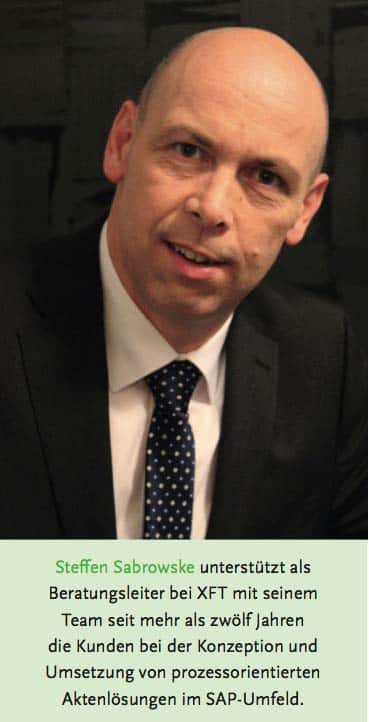Procure overview
![[shutterstock.com:328882406, leolintang]](https://e3mag.com/wp-content/uploads/2016/09/shutterstock_328882406_green_CMYK.jpg)

 Alongside the topics of mobility, automation and digitization, process-oriented work is still a challenge in many companies that has fallen somewhat into the background in recent years.
Alongside the topics of mobility, automation and digitization, process-oriented work is still a challenge in many companies that has fallen somewhat into the background in recent years.
Particularly in traditional business areas such as purchasing, sales and finance, function-oriented work based on established application functions accompanied by parallel documentation processes is the order of the day.
All too often, holistic transparency and traceability of decisions fall by the wayside. Efficient processing and securing of legal and company-agreed compliance requirements is only possible with corresponding additional effort.
The reduction of so-called non-value-added activities in order to lower process costs while improving the ability to provide information and the quality of information continues to be a necessary task that companies are confronted with.
The example of procurement processes and their handling in purchasing is intended to illustrate the potential that can result from integrated process-oriented work using the established standard functions along the process.
The example of procurement processes clearly shows the challenges that companies face, particularly in complex procurements.
Even in the run-up to such processes, tasks and documents are generated that are managed on paper or electronically and stored decentrally. If the corresponding requisitions are then entered in the system, these documents and information usually remain managed decentrally and are not stored in the system with the documents in a process-related manner.
Create transparency
This means that the entire process can only be traced with considerable effort and usually not completely. As a result, the traceability and transparency of processes often fall by the wayside.
Release scenarios of requirement requests or purchase orders are usually mapped in the system in such a way that it is not possible, or only possible by technically experienced users, to understand where an approval is currently pending and who the next approver is.
Inquiries about the status of the release of a procurement transaction can only be answered vaguely. The problem is exacerbated when you want to get an overview of the status of releases across multiple procurement transactions. Be it to switch to alternative releases by other release authorizations or to get an overview of pending tasks of a team.
The processing of the order, for example in the case of the use of the SAP application, takes place via established functions and generates corresponding documents and outgoing documents as a result. Accordingly, the storage and management of the documents assigned to a document is usually also carried out.
This applies to everything from requisitions to purchase orders, order confirmations, goods receipt documents, and invoices. With a process-oriented filing structure that builds up automatically, ensures a certain minimum level of documentation and is available via central access to all relevant documents and information objects, relationships can be identified and viewed more quickly and efficiently.
Time-consuming navigation and possibly manual compilation in clarification cases via individual documents of the overall process can thus be avoided.
Obtain information from the environment
When entering and processing transactions, it is often necessary to obtain information from the environment or documents that were generated in advance. Here, too, targeted and fast access to these documents is desirable, without having to navigate awkwardly via object links.
In the case of procurement processes, this includes above all access to contracts or supplier-related documents. In order to optimally support the process-oriented handling of procurement transactions, the use of an electronic process file - procurement transaction file - is recommended. Ideally, this file is generated automatically and records and manages all relevant information, receipts and documents generated from the system in a structured manner.
If this approach is extended still by the functions necessary for the complete completion, ideally the used standard functions, a processing of the procurement procedure integrated from the process file is possible.
Automated processing
Solutions such as the XFT Purchase Manager enable the complete handling of a procurement process in SAP ERP, from the automated creation of procurement transaction files with release processes for different release scenarios (including mobile release based on SAP UI5) to the process-accompanying documentation via an integrated creation and assignment of SAP purchase orders from the procurement process. How can such approaches be used and what do they achieve?
With this approach, purchasing staff can access a central application for handling procurement processes that integrates established standard SAP Materials Management and Financials functions.
Alternative release scenarios are available for the different requirements for release and approval. With integrated transaction files, a high degree of automation can be achieved in the documentation and updating of process documentation, and all information, including the status of procurement transactions, can be accessed centrally and evaluated.
This can result in a significant reduction in process costs through integrated working and the avoidance of filing, research and preparation efforts.
Ultimately, the documentation of processes and their results along the process chain can ensure internal company and legal compliance requirements.
Not to be forgotten are the further options that arise from these approaches through the integration of further process files, such as complaint processes, clarification cases or the inclusion of supplier and contract files.
Practice has shown that this leads to more efficient processing and greater transparency in purchasing.





